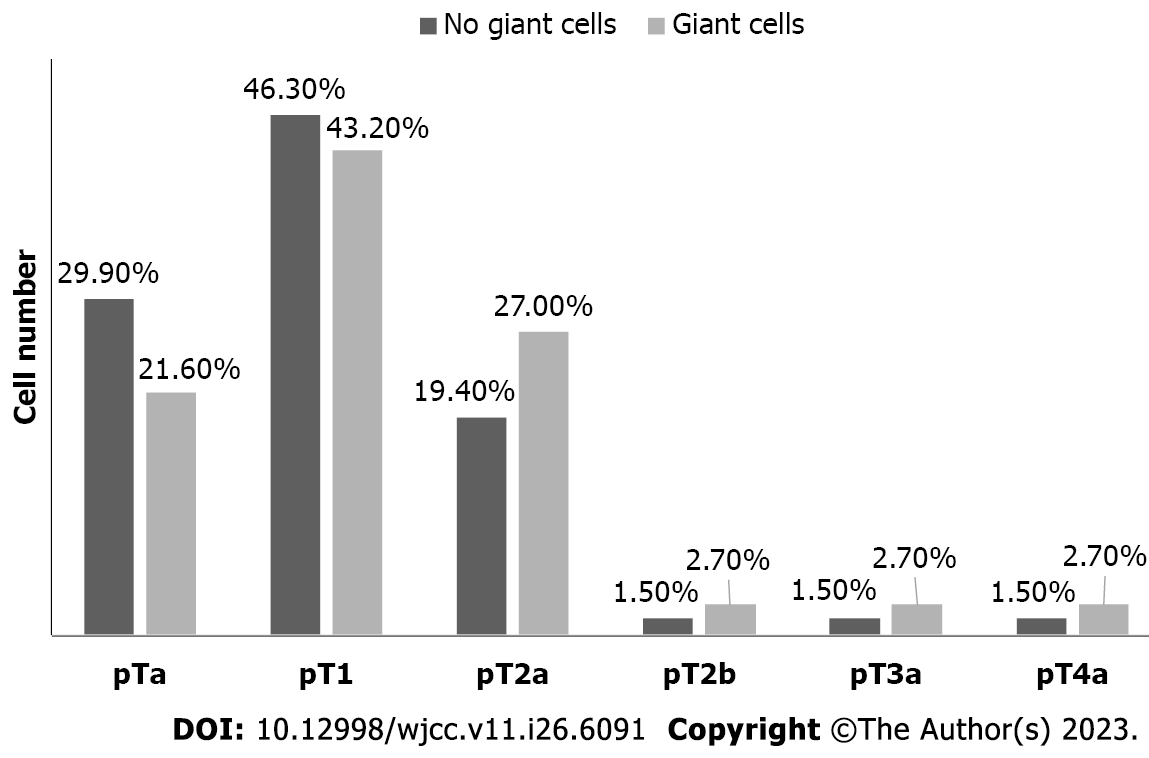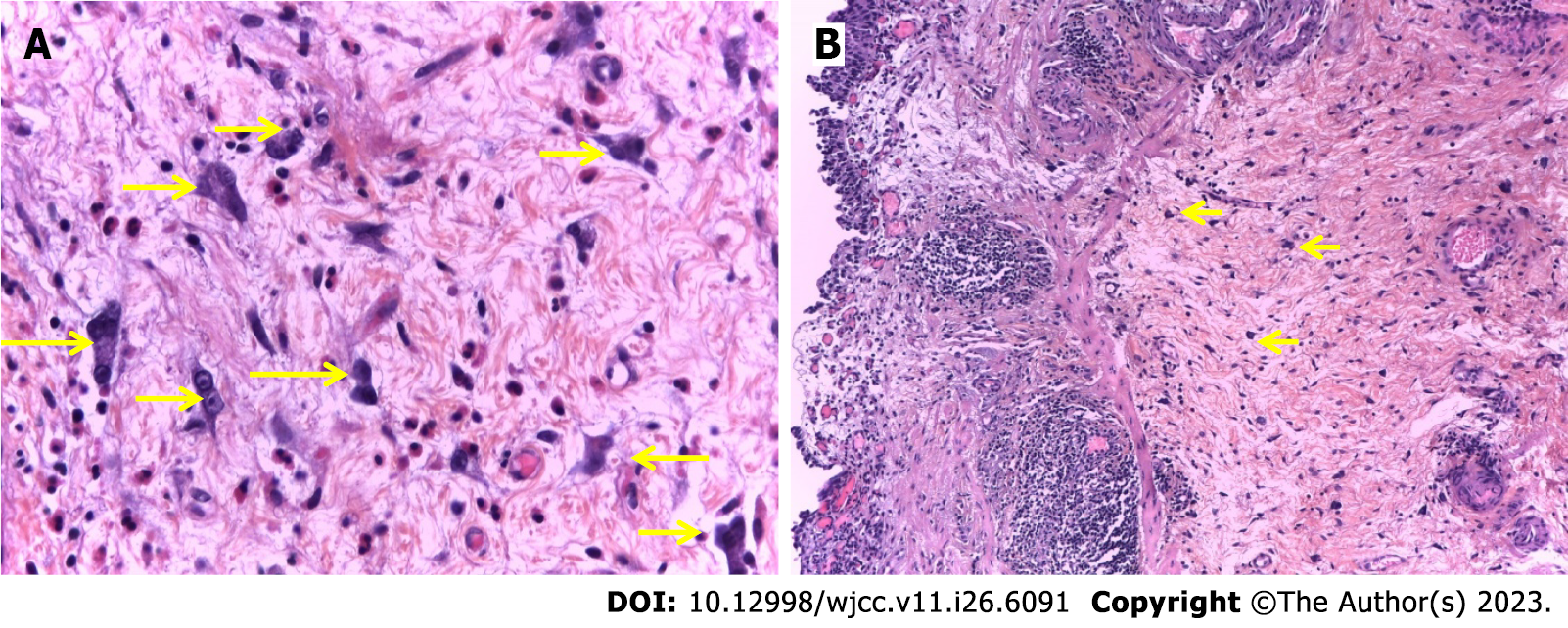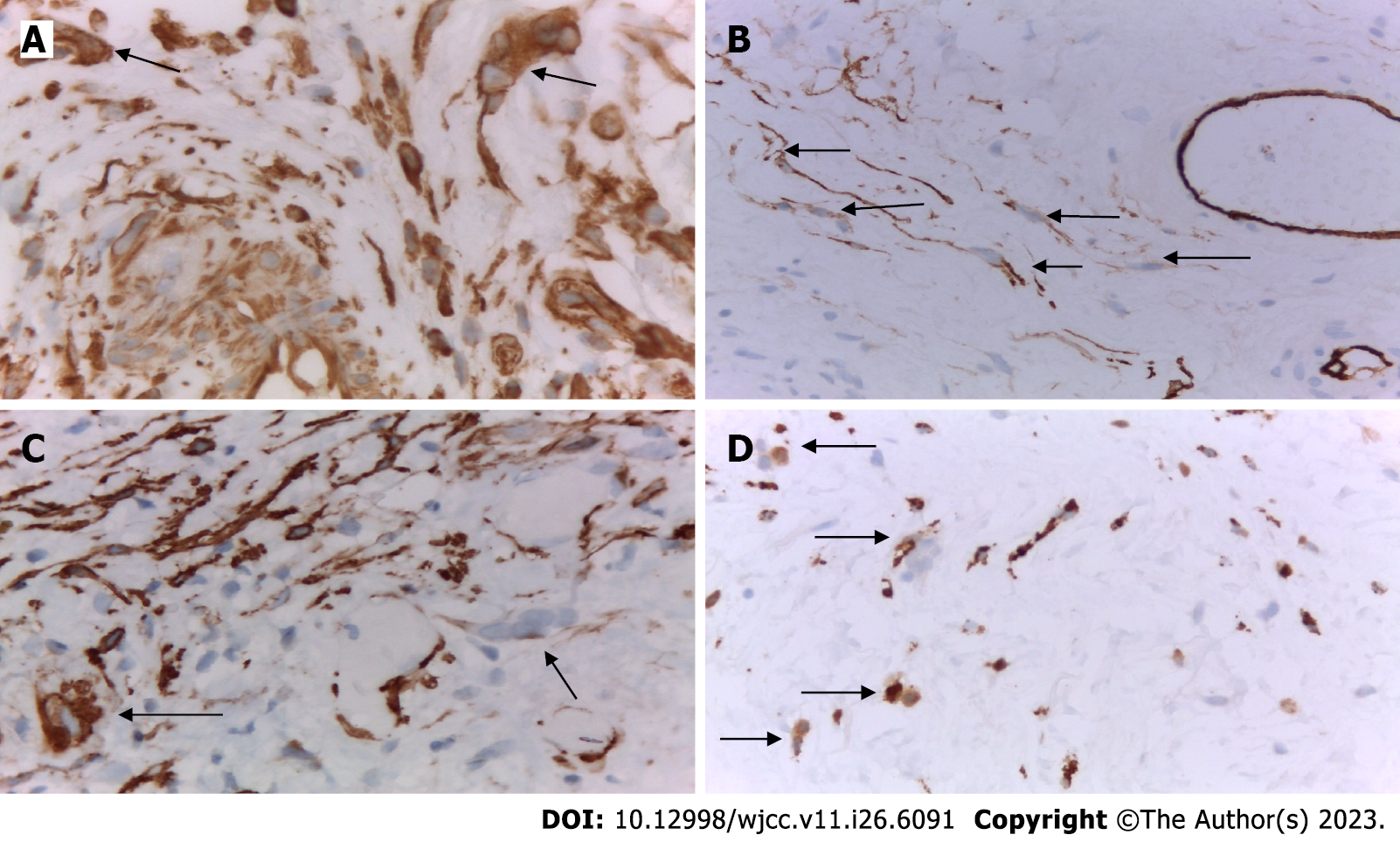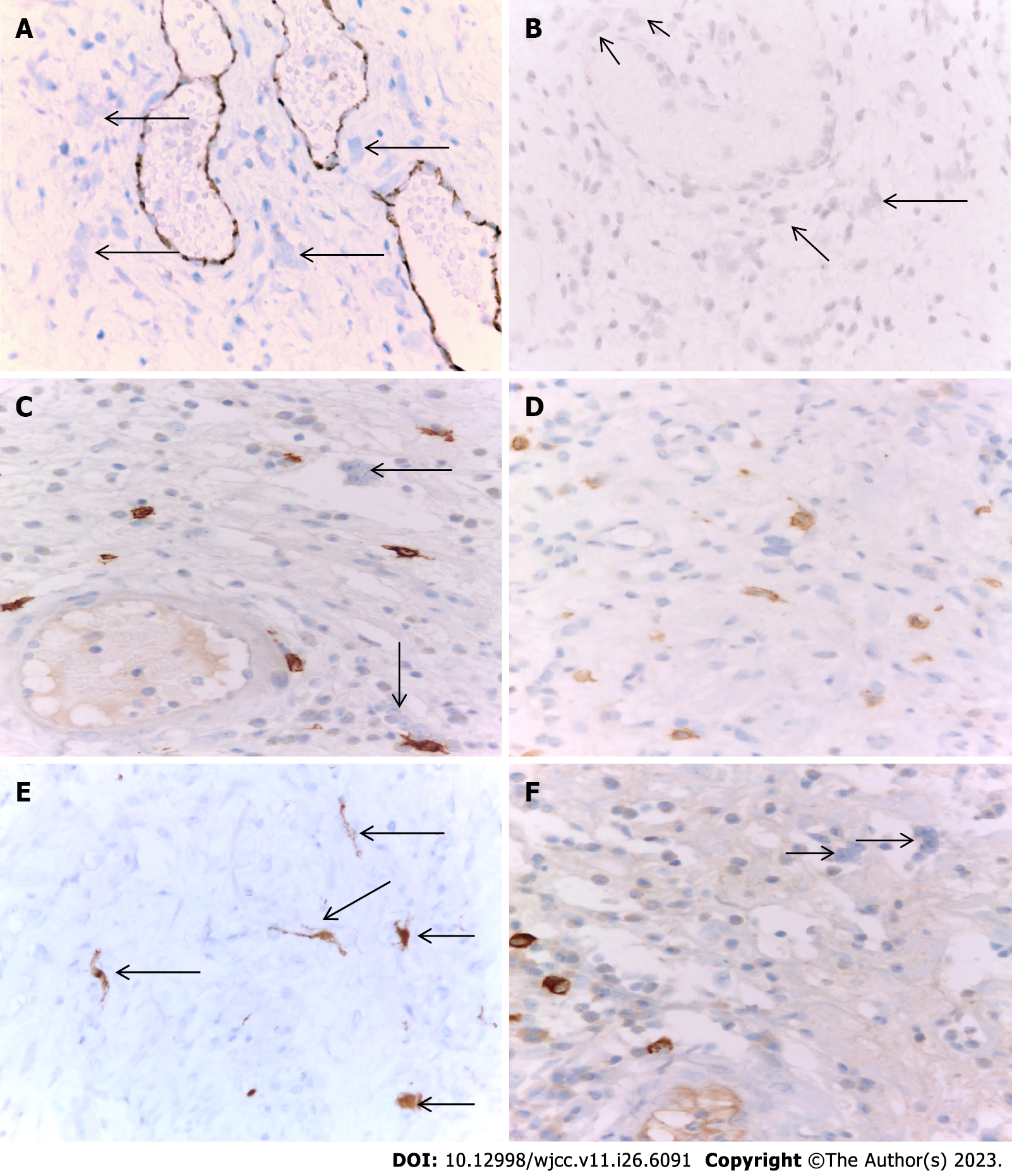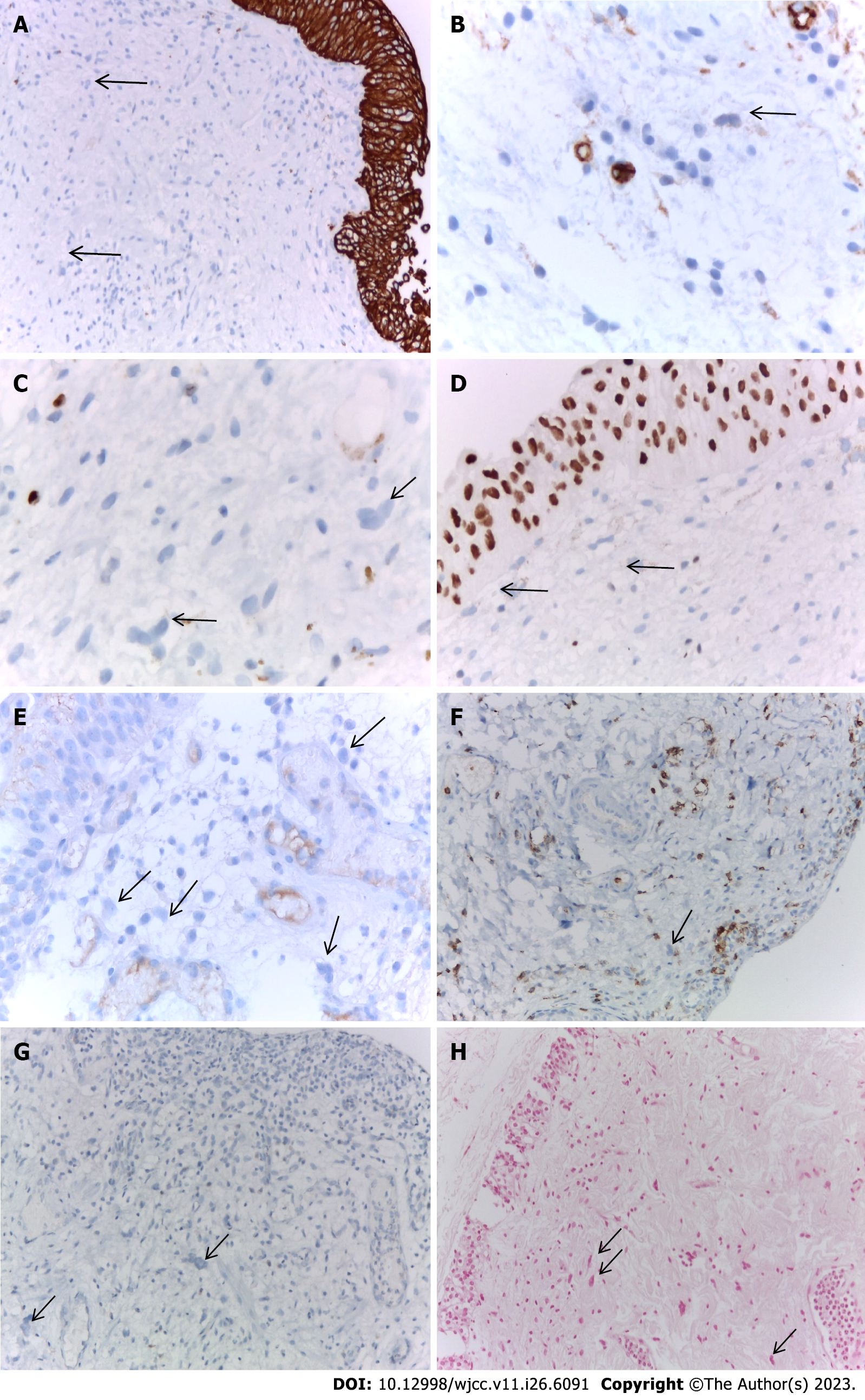Copyright
©The Author(s) 2023.
World J Clin Cases. Sep 16, 2023; 11(26): 6091-6104
Published online Sep 16, 2023. doi: 10.12998/wjcc.v11.i26.6091
Published online Sep 16, 2023. doi: 10.12998/wjcc.v11.i26.6091
Figure 1 Presence of giant stromal cells in correlation with bladder urothelial carcinoma grading.
According to World Health Organization 2016.
Figure 2 Presence of multinucleated giant cells correlated with the TNM-stage.
A tendency for a progressive increase in the number of multinucleated giant cells with an increasing degree of tumor invasion, with a peak in the pT1 stage in urothelial carcinoma of the bladder, is observed.
Figure 3 Conventional histological examination of urothelial carcinoma of the bladder.
A: Presence of atypical mono-, bi- and multin urothelial carcinoma (UC) leated giant fibroblast-like stromal cells (arrow) in the vesicular lamina propria adjacent to non-invasive papillary low-grade (LG) UC. A nonspecific stromal inflammatory response rich in plasma cells and eosinophilic leukocytes accompany them. hematoxylin-eosin, 400 ×; B: Presence of multinucleated giant cells in the bladder lamina propria (arrow) in close proximity to tertiary lymphoid structures of type 2 and 3 (2nd and 3rd degree) and with non-invasive papillary LG UC. hematoxylin-eosin, 100 ×.
Figure 4 Immunohistochemical examination of urothelial carcinoma of the bladder.
A: Presence of two pericapillary multinucleated giant cells (MGCs) in the mucosa that were vimentin-positive (arrow). Immunohistochemical (IHC), VIMENTIN × 630; B: Presence of several pericapillary MGCs in the mucosa, which were CD34 + positive (arrow); the cells in the wall of the surrounding capillaries served for internal positive control. IHC, CD34 × 400; C: Presence of two pericapillary MGCs in the mucosa, the growths of which were positive for smooth muscle actin (arrow); the cells in the wall of the surrounding capillaries served as an internal positive control. IHC, SMA × 400; D: Presence of several MGCs in the mucosa whose cytoplasm was positive for the macrophage marker CD68 (arrow); mononuclear macrophages the context of the inflammatory infiltrate served as an internal positive control. IHC, CD68 × 400.
Figure 5 Immunohistochemical examination of urothelial carcinoma of the bladder.
A: Presence of several pericapillary multinucleated giant cells (MGCs) in the mucosa, which were CD31-negative (arrow); the endothelial cells of the surrounding capillaries served for internal positive control. immunohistochemical (IHC), CD31 × 400; B: Presence of several pericapillary MGCs in the mucosa, which were CD10-negative (arrow). IHC, CD10 × 400; C: The presence of two pericapillary MGCs in the bladder’s mucosa, which were found negative for C-KIT (arrow); positively labeled pericapillary mast cells were used for internal positive control. IHC, C-KIT × 630; D: MGCs in the bladder mucosa were always accompanied by many pericapillary C-KIT positive mast cells. IHC, C-KIT × 630; E: Giant cells were p16-positive (arrow). IHC, p16 × 400; F: Presence of two pericapillary MGCs in the mucosa that are negative immunoglobulin G4 (IG G4) for IG G4; several positively labeled pericapillary plasma cells were used for internal positive control. IHC, IG G4 × 630.
Figure 6 Immunohistochemical examination of urothelial carcinoma of the bladder.
A: Multinucleated giant cells (MGCs) with a negative expression for CK AE1/AE3, a positively marked LG urothelial carcinoma served for internal positive control. immunohistochemical (IHC), CK AE1/AE3 × 200; B: MGCs lacking expression for CD34 blast- (arrow), the surrounding capillaries served as an internal positive control. IHC, CD34blast × 400; C: MGCs were negative for Ki-67- (arrow), mononuclear inflammatory cells served as an internal positive control. IHC, Ki-67 × 630; D: MGCs were negative for GATA3- (arrow), for internal positive control serves the surrounding urothelial mucosa. IHC, anti-GATA3 × 400; E: MGCs with negative expression for PD-L1 (arrow). IHC, anti-PD-L1 × 400; F: MGC was negative for CD45 (arrow). IHC, CD45 × 200; G: MGCs were negative for CD1A (arrow). IHC, CD1A, × 200; H: Giant cells were negative for Perls staining (arrow). Perls, × 200.
Figure 7 The algorithm for diagnosis multinucleated giant cells in the stroma of a tumor and non-tumor bladder.
IHC: Immunohistochemical; MGC: Multinucleated giant cell.
- Citation: Gulinac M, Velikova T, Dikov D. Multinucleated giant cells of bladder mucosa are modified telocytes: Diagnostic and immunohistochemistry algorithm and relation to PD-L1 expression score. World J Clin Cases 2023; 11(26): 6091-6104
- URL: https://www.wjgnet.com/2307-8960/full/v11/i26/6091.htm
- DOI: https://dx.doi.org/10.12998/wjcc.v11.i26.6091










